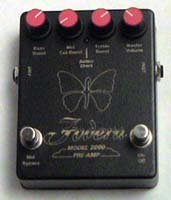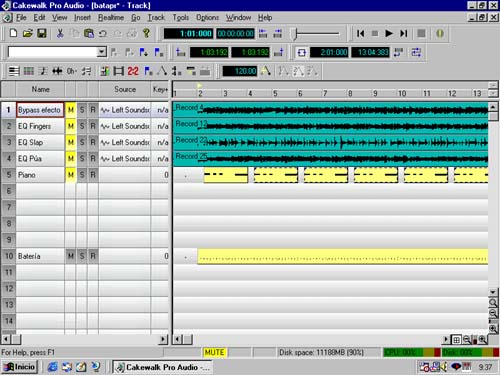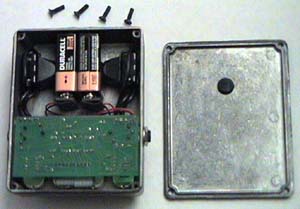FODERA
MODEL 2000 PREAMP
by Sebastián Caffini
A sign of a new
trend in the music industry: In recent years the market has been invaded by more
and more preamps encased in small boxes, about the size of a footpedal or even
smaller, like the one we’re evaluating in this test.
Why would this be?
The trailblazer in this trend is renowned NYC luthier Roger Sadowsky, pioneer in
offering “outboard” preamps. This means, preamps to be used outside the body
of the instrument. After the huge repercussion he achieved among bassists as the
mastermind behind Marcus Miller’s sound (for which he heavily modified the
’70s Fender Jazz Marcus often plays), good old Roger had the great idea of
offering the same electronic circuitry (which is also standard in the
instruments Roger builds under his name) inside a metal box pretty much similar
to this one you see here.

That way, he
hoped to supply a solution to those bassists who were unwilling to modify a
vintage instrument or unable to go all the way to Manhattan to have the work
done in their basses.
In the case of the
product reviewed in this test, the story is similar: Vinnie Fodera & Joe
Lauricella are also two very respected New York luthiers, who’ve built their
world wide fame on the instruments. These creations are certainly impressive,
played by monsters players such as Anthony Jackson and Victor Wooten.
Now, they offer
this preamp designed by bassist Mike Pope, which we’re evaluating thanks to
the courtesy of our friend Danny Ianniruberto, bass player for Argentine
progressive/synth rockers NEXUS. Danny bought it in NYC during the last band
tour, and graciously lent it to us for this review. List price is $299 US, but
you’ll surely score a better deal if you pay in cash.
The
environment: we
divided this test in two parts. First, we plugged into a Hartke Model 3500 head
matched with two Hartke XL series cabinets, a 1x15 and a 4x10; after that, we
tested the unit by recording some tracks directly to hard disk in our home
recording setup (pretentiously named “Seba Sound Systems”), consisting of
Cakewalk Pro Audio 9 software running into a 500Mhz Pentium III PC.

In both cases we
used my main bass, a Modulus VJ4 with Bartolini passive pickups and a Moon AC-1
active preamp. In both cases, also, we set the instrument controls in flat
position and the volume controls all the way up. During the “plugged into the
amp” test stage, we also disengaged the Hartke’s graphic EQ and set the bass
and treble rotary controls in flat position.
Description: The device, as it says in the user’s manual (which was very
thorough), is made in the USA, although in the inside of the metal box it reads
“made in Canada” (which probably refers to the case only and not to the
components).
As you can see in
the above picture, the controls in the Model 2000 are pretty intuitive: bass,
middle, treble and general gain, plus two step-on switches that let you bypass
the mid control (mid bypass) or the entire circuitry (on/off).
It should be noted
that both the bass and treble control offer boost only, so the flat position for
those controls is achieved by rolling the knobs completely counterclockwise; the
mid control, on the other hand, offers both boost and cut, so the flat position
is located halfway of the knob’s range of movement.
The only
disadvantage, although minimal, we found in the unit’s design is this: it only
works with 9 volt
batteries (two of
them, which makes for a 18 volt circuit that yields a better signal-to-noise
ratio). This means it is not possible to plug directly into AC through a
transformer, and to change batteries it’s necessary to remove the four screws
that hold the bottom plate

This minor detail
aside, the Model 2000 left us with a very positive impression, structurally
speaking: it’s built solidly enough to tolerate use and abuse in live
situations and the jacks keep the cords firmly held.
Given its
simplicity of design, using the Model 2000 isn’t too much
a trouble; you only have to plug in a couple of cables and start
experimenting...
Into
the amp: right after we plugged into the amp, the first impression the Model
2000 left on us was this: it offers A LOT of gain. For pure instinct, we left
the gain control at 12 o’ clock, and when we engaged the preamp by stepping on
the on/off switch, our attention was caught by the enormous difference in the
signal’s strength. That indicates this unit was clearly designed with
all-passive basses in mind. Even so, we’d recommend being very careful with
that gain control: the resulting signal could easily be too hot for some amp
inputs to handle and clip the amp’s pre stage (not nice!).
After the gain
control was adjusted (and the amount of gain was controlled), we had a very easy
time finding the desired sounds. The knobs rotate smoothly and are pretty
sensitive: even a minimal modification in the position of the knobs results in a
clearly perceptible difference in sound.
After a while of
experimenting we found our favorite combinations to be the following: for
fingerstyle playing, bass at one o’ clock, mid engaged with the control at
eight o’clock, and treble at eleven o’clock.
This
gave us the tone with better weight in the lower register and better
definition in the whole range of the instrument. For pick playing, bass at two
o’clock, mid engaged with the knob at eleven o’clock and treble at ten
o’clock gave us a very “cutting” sound, but robust enough down low to not
get lost behind other instruments. For slapping, Fodera & Lauricella
recommend disengaging the mid circuitry ...and you should believe them. Adding
bass at two o’clock and treble at eleven o’clock, the slap sound is
unbeatable: warm, round and with such a clear attack the bass breaks through in
any mix. Impressive.
In
the studio: When we
plugged into the amp we were pleasantly surprised with the very little
(actually, almost nonexistent) noise the Model 2000 produces, given the amount
of gain and generous EQ potential it provides. We thought that in recording
direct to hard disk that first impression would change, because there wouldn’t
be any of the noise inherent to any amp helping to mask the hiss that any signal
processing device adds to a signal.
And the Model 2000
surprised us once again. We recorded a basic drum groove and some piano chords,
and then we recorded four bass tracks: one with the effect completely bypassed,
one with the aforementioned “fingers” EQ setting, one with the “pick” EQ
setting and one with the “slap” EQ setting (see illustration). Every EQ
setting maintained the good performance shown during the “in the amp” test,
and (this is what we found the most surprising) we couldn’t perceive any
unwanted noise in any of the takes, neither soloing the tracks nor combining
them with the other parts.
A word of warning,
though. We’ll sound repetitive, but we’ll say it again: this device adds
lots of gain, so keep that in mind when playing in the studio so you won’t
clip the input of the mixing console, tape deck or (as in our case) the input of
your soundcard.
To
wrap it up: even
though the Model 2000 was clearly designed to work best with passive
instruments, we believe every bass would benefit from its impressive EQ
capabilities. It’s powerful, it’s built like a tank, it’s easy to operate,
it’s quiet and will perform its function flawlessly both live and in the
studio. The hard part, depending on where you live, will be getting one, since
Fodera doesn’t have (as far as we know) a big international distribution
network. Anyway, you can try buying one online on the websites of the big
American music instrument stores, or through Fodera’s own site, at
http://www.fodera.com
Read
this article in Spanish
